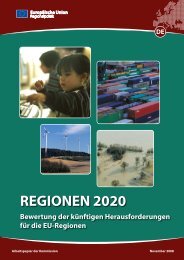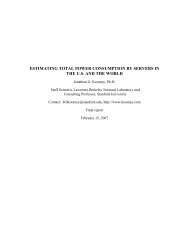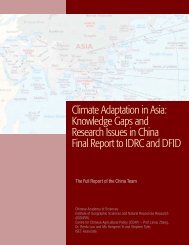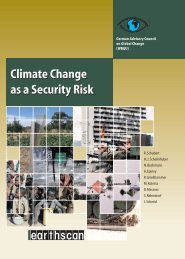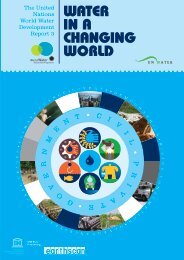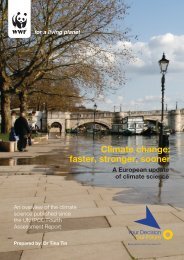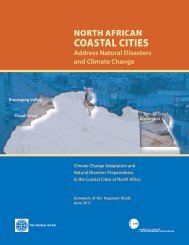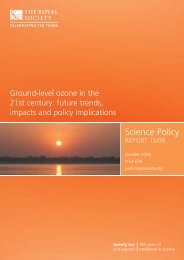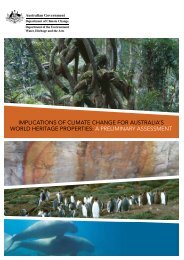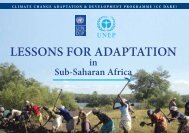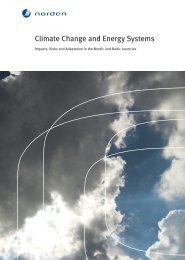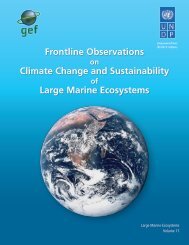CONCLUSIONSAND RECOMMENDATIONSJust as we underestimated the rate at which climatewould <strong>change</strong>, the biological responses to that<strong>change</strong> <strong>and</strong> the costs we would incur, we may haveunderestimated the manifold benefits we can derivefrom a clean energy transition.The financial sector — having a long time-horizon <strong>and</strong>a diversified international portfolio — is the centralnervous system of the global economy, sensing disturbanceswhen they begin to percolate in many parts ofthe globe. Energy lies at the heart of all our activities<strong>and</strong> all of nature’s processes. With the energy infrastructurein trouble, insurers may soon be asking if thefuture is insurable.FOSTERING AWARENESS OF CARBON RISKS,EXPOSURES AND OPPORTUNITIESUnderst<strong>and</strong>ing the risks <strong>and</strong> opportunities posed by climate<strong>change</strong> <strong>and</strong> sensitizing others is the first steptowards taking corrective measures. A broad educationalprogram is needed to better inform businesses,regulators, governments, international bodies <strong>and</strong> thepublic as to the science <strong>and</strong> impacts of climate<strong>change</strong>. The <strong>health</strong> of large regional <strong>and</strong> globalecosystems that support us is at stake.Regulators <strong>and</strong> governments need to underst<strong>and</strong> thescience in order to frame regulations in climate-friendlyways. Special attention should be given to identifyingmisaligned incentives <strong>and</strong> market signals that perpetuateenvironmentally destructive practices.Of the three emerging exposures for the insurance <strong>and</strong>investment sectors — climate instability, terrorism <strong>and</strong>tectonic shifts — the first two may be directly or indirectlytied to our dependence on oil. Exiting from the ageof oil is the first <strong>and</strong> necessary step toward improvingthe environment <strong>and</strong> our security <strong>and</strong> achieving sustainabledevelopment (Epstein <strong>and</strong> Selber 2002).Together, finance, UN agencies, scientists <strong>and</strong> civilsociety can seize the opportunities. The combination ofa) focused lending <strong>and</strong> investment, b) targeted insurancecoverage, <strong>and</strong> c) sufficient <strong>economic</strong> incentivesfrom governments <strong>and</strong> international financial institutionscan jump-start “infant” industries <strong>and</strong> sustain an <strong>economic</strong>allyproductive, clean energy transition.POLICIES AND MEASURESThe global nature of the problems associated with arapidly changing climate often seems overwhelming.Multiple measures at various levels are required, butthe political will to undertake them is often difficult toinitiate, much less sustain. Coordinating actions by variousstakeholders can be particularly daunting.Yet <strong>change</strong> is necessary, <strong>and</strong> involvement of all sectorsof society is needed. With careful steering <strong>and</strong> anexpansive dialogue, societies can reduce risks <strong>and</strong>benefit from the opportunities. With this in mind, theeditors <strong>and</strong> authors of this report have divided proposalsinto two categories — fostering awareness <strong>and</strong>taking action.Firms can better underst<strong>and</strong> their own exposures to thephysical <strong>and</strong> emerging business risks — including litigation,legislation, shifts in consumer choices <strong>and</strong>activism within civil society. In the energy transitionahead, companies can identify ways to profitablyaddress the challenges.For insurers, climate <strong>change</strong> challenges all aspects oftheir core business, including property <strong>and</strong> casualty,life <strong>and</strong> <strong>health</strong>, <strong>and</strong> financial services. Insurers canamass more pertinent information on climate risks asthe past becomes a less informative predictor of thefuture <strong>and</strong> share this knowledge with other stakeholdersthrough interactive dialogues.Investors <strong>and</strong> financial analysts can evaluate portfoliosfor climate risks <strong>and</strong> opportunities, <strong>and</strong> capital marketprofessionals can add climate screens to their study ofbalance sheets <strong>and</strong> market possibilities. Capital marketssometimes miss the “signals” coming from climate,paying attention only to large, obvious events such ashurricanes <strong>and</strong> typhoons.And citizens can learn about their own carbon footprint— the amount of carbon their own activitiesrelease into the environment — driven by their consumptionpatterns <strong>and</strong> political choices. Civil societyhas a central role to play in building awareness in allsectors <strong>and</strong> helping businesses, governments <strong>and</strong> internationalfinancial institutions formulate measures for fundamental<strong>change</strong> to achieve clean <strong>and</strong> sustainabledevelopment.107 | FINANCIAL IMPLICATIONS
Finally, new technologies need to be clean <strong>and</strong> safe.Those intended to adapt to climate <strong>change</strong> <strong>and</strong> disease,such as genetically modified organisms, need tobe fully evaluated as to their implications for naturalsystems. Those aimed at climate mitigation, includingcarbon sequestration, coal gasification <strong>and</strong> exp<strong>and</strong>eduse of nuclear power, must undergo thorough scrutinyregarding their repercussions for <strong>health</strong>, ecology <strong>and</strong>economies. Life cycle analysis of proposed solutionscan form the basis of those assessments.Corporate executive managements can declare theircommitment to principles of sustainability, such asthose of Ceres <strong>and</strong> the Carbon Disclosure Project, <strong>and</strong>develop codes, such as those enunciated by theEquator Principles, to guide financial institutions inassessing climate-related risks <strong>and</strong> specifying environmental<strong>and</strong> social risks in project financing. Firms canmake their own facilities energy-efficient <strong>and</strong> encouragecarbon-reducing measures, such as telecommuting<strong>and</strong> the use of virtual business tools.108 | FINANCIAL IMPLICATIONSACTION: SEIZING OPPORTUNITIES AND CUTTINGCARBON EMISSIONSThe next step is reducing the output of greenhousegases, <strong>and</strong> this will require concerted efforts by allstakeholders. A framework for solutions is the following:• Significant, financial incentives for businesses<strong>and</strong> consumers.• Elimination of perverse incentives (Myers <strong>and</strong> Kent1997) that subsidize carbon-based fuels <strong>and</strong>environmentally destructive practices.• A regulatory <strong>and</strong> institutional framework designed topromote sustainable use of resources <strong>and</strong> constrainthe generation of wastes.A set of integrated, reinforcing policy measures isneeded. The chief issue is the order of magnitudeof the response. The Kyoto Protocol calls for 6-7%reduction of carbon emissions below 1990 levels by2012, while the IPCC calculates that a 60-70%reduction in emissions is necessary to stabilize atmosphericconcentrations. How large an investment wemake in our common future will be a function of theeducational process <strong>and</strong> how rapidly the reality of climate<strong>change</strong> affects our lives.The scenario process enables us to envision a futurewith widespread impacts <strong>and</strong> even climate shocks(such as slippage of portions of Greenl<strong>and</strong>).”Imagining the unmanageable” can help us take constructivesteps in the short term, while making contingencyplans for even bolder, more rapid transformationsin the future.Each sector can play a part <strong>and</strong> develop partnershipsto catalyze progress. Individuals <strong>and</strong> the institutions inwhich they are active (schools, religious institutions,workplaces, communities <strong>and</strong> municipalities) can makeconsumption decisions <strong>and</strong> political choices that influencehow our future unfolds.An enormous challenge — that can spawn many <strong>economic</strong>activities — is the task of <strong>ecological</strong> restoration.Large programs are needed to restore Florida’secosystems <strong>and</strong> the Gulf coast’s barrier wetl<strong>and</strong>s <strong>and</strong>isl<strong>and</strong>s. Other industries will be needed to constructbuildings <strong>and</strong> new infrastructure, improve transport systems<strong>and</strong> plan cities to meet the requirements of thecoming climate.Governments, in partnerships with international organizations<strong>and</strong> businesses, can help transfer new technologies<strong>and</strong> manufacturing capability to developingnations. Encouraging consumers to purchase productsthat set aside part of the price to pursue climate friendly(‘footprint neutral’) projects is just one commercialinnovation being developed. The global sharing ofbest practices can help reduce the number <strong>and</strong> intensityof resource wars that may loom if only temporizingmeasures are adopted.Insurers, along with their clients, can facilitate developmentof low carbon technologies through their policies<strong>and</strong> new products <strong>and</strong> can set the pace for othersstriving to become greenhouse gas neutral. Risk perceptioncan be an obstacle to adopting new technologies,<strong>and</strong> the insurance industry can influence commercialbehavior by creating products that transfer someof the risk away from investors. It was insurance coverageonly for buildings with sprinkler systems, for example,that enabled the construction of skyscrapers in theearly 20th century. Policies today could help redirectsociety’s future energy diet <strong>and</strong> speed development ofbeneficial technologies.Investors at all levels, <strong>and</strong> especially institutionalinvestors such as state <strong>and</strong> union pension funds, c<strong>and</strong>irect capital toward renewable energy technologies.Project finance <strong>and</strong> new financial instruments can providestimulus for solar, wind, geothermal, tidal <strong>and</strong>hybrid technologies <strong>and</strong> help drive the clean energytransition. Capital markets can foster the development
- Page 1 and 2:
Climate Change FuturesHealth, Ecolo
- Page 4 and 5:
Table of ContentsIntroductionPart I
- Page 6 and 7:
EXECUTIVE SUMMARYClimate is the con
- Page 8 and 9:
the past decade, an increasing prop
- Page 10 and 11:
THE CASE STUDIES IN BRIEFInfectious
- Page 12 and 13:
THE INSURER’S OVERVIEW:A UNIQUE P
- Page 14:
Regulators and governments can empl
- Page 17 and 18:
THE PROBLEM:CLIMATE IS CHANGING, FA
- Page 19 and 20:
Figure 1.3 GreenlandEXTREMESOne of
- Page 21 and 22:
20 | THE CLIMATE CONTEXT TODAYWholl
- Page 23 and 24:
Figure 1.5 Global Weather-Related L
- Page 25 and 26:
Climate signals in rising costs fro
- Page 27 and 28:
CLIMATE CHANGE CANOCCUR ABRUPTLYPer
- Page 29 and 30:
28 | THE CLIMATE CONTEXT TODAYCCF-I
- Page 31 and 32:
communities, salinizing ground wate
- Page 33 and 34:
Health is the final common pathway
- Page 35 and 36:
34 | INFECTIOUS AND RESPIRATORY DIS
- Page 37 and 38:
Figure 2.4 Malaria and Floods in Mo
- Page 39 and 40:
Figure 2.61920-1980CASE STUDIES38 |
- Page 41 and 42:
A MALARIA SUCCESSThe New York Times
- Page 43 and 44:
A new flavivirus, Usutu, akin to WN
- Page 45 and 46:
44 | INFECTIOUS AND RESPIRATORY DIS
- Page 47 and 48:
One analysis (Vanderhoof and Vander
- Page 49 and 50:
BIODIVERSITYBUFFERS AGAINSTTHE SPRE
- Page 51 and 52:
Figure 2.15 RagweedMOLDSLong-term f
- Page 53 and 54:
ASTHMA COSTSTODAYexamples, the Afri
- Page 55 and 56:
Stott et al. (2004) calculate that
- Page 57 and 58: In the summer of 2005, northern Spa
- Page 59 and 60: a better understanding of subpopula
- Page 61 and 62: 60 | EXTREME WEATHER EVENTSFLOODSFO
- Page 63 and 64: MOSQUITO- AND SOIL-BORNE DISEASESEC
- Page 65 and 66: Table 2.2 Direct and Indirect Healt
- Page 67 and 68: HEALTH AND ECOLOGICALIMPLICATIONSOu
- Page 69 and 70: 68 | NATURAL AND MANAGED SYSTEMSCAS
- Page 71 and 72: Figure 2.27 Soybean Sudden Death Sy
- Page 73 and 74: 72 | NATURAL AND MANAGED SYSTEMSCAS
- Page 75 and 76: 74 | NATURAL AND MANAGED SYSTEMSCAS
- Page 77 and 78: 76 | NATURAL AND MANAGED SYSTEMSCAS
- Page 79 and 80: 78 | NATURAL AND MANAGED SYSTEMSTHE
- Page 81 and 82: HARMFUL ALGALBLOOMSFigure 2.32 Red
- Page 83 and 84: 82 | NATURAL AND MANAGED SYSTEMSCAS
- Page 85 and 86: CASE STUDIES 84 | NATURAL AND MANAG
- Page 87 and 88: CASE STUDIES 86 | NATURAL AND MANAG
- Page 89 and 90: CASE STUDIES 88 | NATURAL AND MANAG
- Page 91 and 92: CASE STUDIES 90 | NATURAL AND MANAG
- Page 93 and 94: “Climate change is one of the wor
- Page 95 and 96: 94 | FINANCIAL IMPLICATIONS• Incr
- Page 97 and 98: Extreme weather events are a partic
- Page 99 and 100: 98 | FINANCIAL IMPLICATIONSTable 3.
- Page 101 and 102: 100 | FINANCIAL IMPLICATIONSdemand
- Page 103 and 104: 102 | FINANCIAL IMPLICATIONSClimate
- Page 105 and 106: These include:Solar Photovoltaic Pa
- Page 107: • Social and economic factors in
- Page 111 and 112: 110 | FINANCIAL IMPLICATIONSBRETTON
- Page 113: 112 | APPENDICESAppendix A. Summary
- Page 116 and 117: Table B.1 Summer Percentage Frequen
- Page 118 and 119: Climate sensitivity for small-scale
- Page 120 and 121: diffuse and do not manifest in sing
- Page 122 and 123: APPENDIX D.LIST OF PARTICIPANTS ATT
- Page 124: Carmenza RobledoGruppe OekologieEMP
- Page 127 and 128: 126 | BIBLIOGRAPHYBibliographyAAAAI
- Page 129 and 130: 128 | BIBLIOGRAPHYChordas, L. Epide
- Page 131 and 132: Ford, S.E. & Tripp, M.R. Diseases a
- Page 133 and 134: 132 | BIBLIOGRAPHYKalkstein, L. S.,
- Page 135 and 136: 134 | BIBLIOGRAPHYMills, E. The ins
- Page 137 and 138: 136 | BIBLIOGRAPHYRose, J. B., Epst
- Page 139 and 140: 138 | BIBLIOGRAPHYVandyk, J. K., Ba
- Page 142: Infectious and Respiratory Diseases



